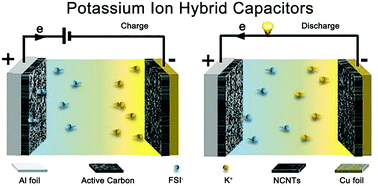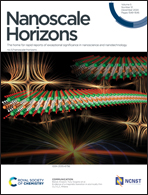Nitrogen-doped carbon nanotubes as an anode for a highly robust potassium-ion hybrid capacitor†
Abstract
Potassium ion hybrid capacitors (KIHCs) have drawn growing interest owing to their outstanding energy density, power density and excellent cycling stability. However, the large ionic radius of potassium triggers a huge volume change during continuous K+ insertion/extraction processes, restricting the development of KIHCs. Here, we report N-doped carbon nanotubes (NCNTs) for high-performance K+ storage. The NCNTs possess a hierarchical structure and N functional groups and not only offer sufficient space to relieve the volume expansion, but also provide highly efficient channels to transport electrons and ions. As a result, the NCNTs anode presents a high specific capacity and an excellent cycling stability with an average decay rate of 0.0238% per cycle (the lowest value among the reported carbon-based anodes for K-ions batteries) during 3600 continuous cycles. A potassium ion hybrid capacitor (KIHC) was also designed with the NCNT anode and a commercial active carbon cathode and achieved both a high energy/power density (117.1 W h kg−1/1713.4 W kg−1) and a long cycle life (2000 cycles at 1 A g−1). Moreover, the in situ Raman and ex situ element mapping characterization demonstrate the outstanding electrochemical reversibility of the NCNTs. This work provides a superior strategy to design low-cost anode materials with excellent K+ storage electrochemistry.

- This article is part of the themed collection: Nanoscale Horizons 2021 Lunar New Year Collection


 Please wait while we load your content...
Please wait while we load your content...